Japanese Egg Sandwich Recipe (Tamago Sando)
I have always been a huge fan of sandwiches, whether it’s the classic egg salad sandwich, a healthy tuna sandwich (one of my favorites), or any other delicious variation. There’s just something incredibly satisfying about the simplicity and versatility of a sandwich. But when it comes to breakfast, my love for egg recipes really shines through.
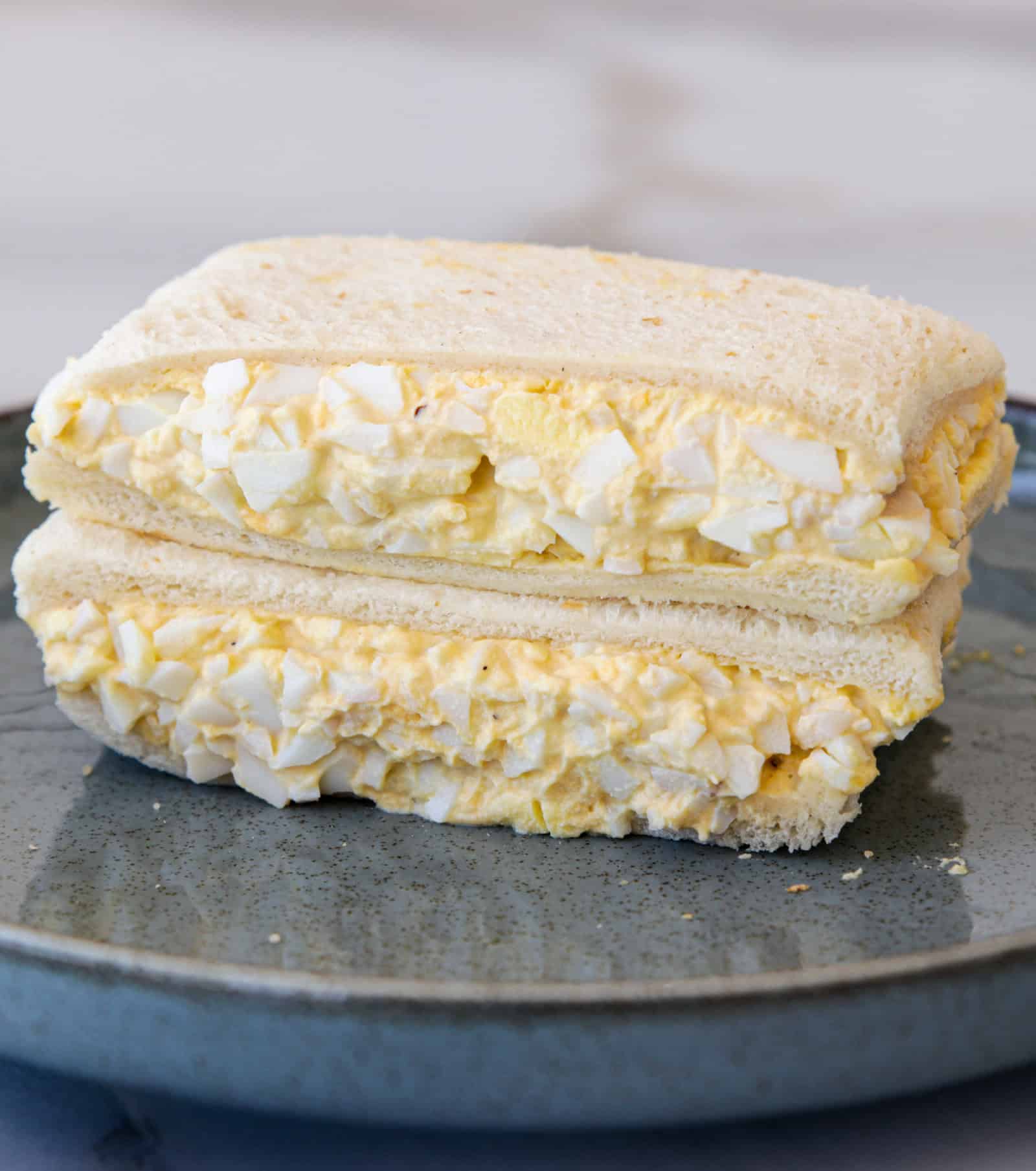
That’s when I discovered the Japanese egg sandwich, also known as tamago sando. This sandwich has quickly become one of my favorites, and it’s no wonder why it’s so popular in Japan. With its fluffy, creamy egg filling and soft, pillowy Japanese milk bread (shokupan), this sandwich is comfort food at its finest. If you love a good egg salad sandwich like I do, this is a must-try twist that will take your sandwich game to the next level. Let me walk you through how to make this incredible Japanese egg sandwich recipe that’s perfect for breakfast or a quick snack!
What is a Japanese Egg Sandwich?

A Japanese egg sandwich (or tamago sando, with “tamago” meaning egg and “sando” being short for sandwich) is a super simple but incredibly tasty sandwich that’s really popular in Japan. It’s made with soft, creamy egg salad that’s usually mixed with Kewpie mayo, which is a little sweeter and tangier than regular mayo. Instead of the chunky egg salad you might be used to, the eggs in this sandwich are mashed up so they’re really smooth, almost like a spread.
What makes it even better is the bread. It’s usually made with shokupan, which is a super soft, fluffy white bread. The crusts are cut off, so all you get is the pillowy bread and creamy filling. It’s seriously like biting into a cloud! The bread and eggs together make it the perfect combo—light, but super filling at the same time.
Even though it’s a really simple sandwich, it’s totally addictive. People love eating it for breakfast or lunch, but honestly, it’s great any time you want a quick, tasty snack. Trust me, once you try it, you’ll get why everyone loves it!
🛒 Ingredients for Japanese Egg Sandwich
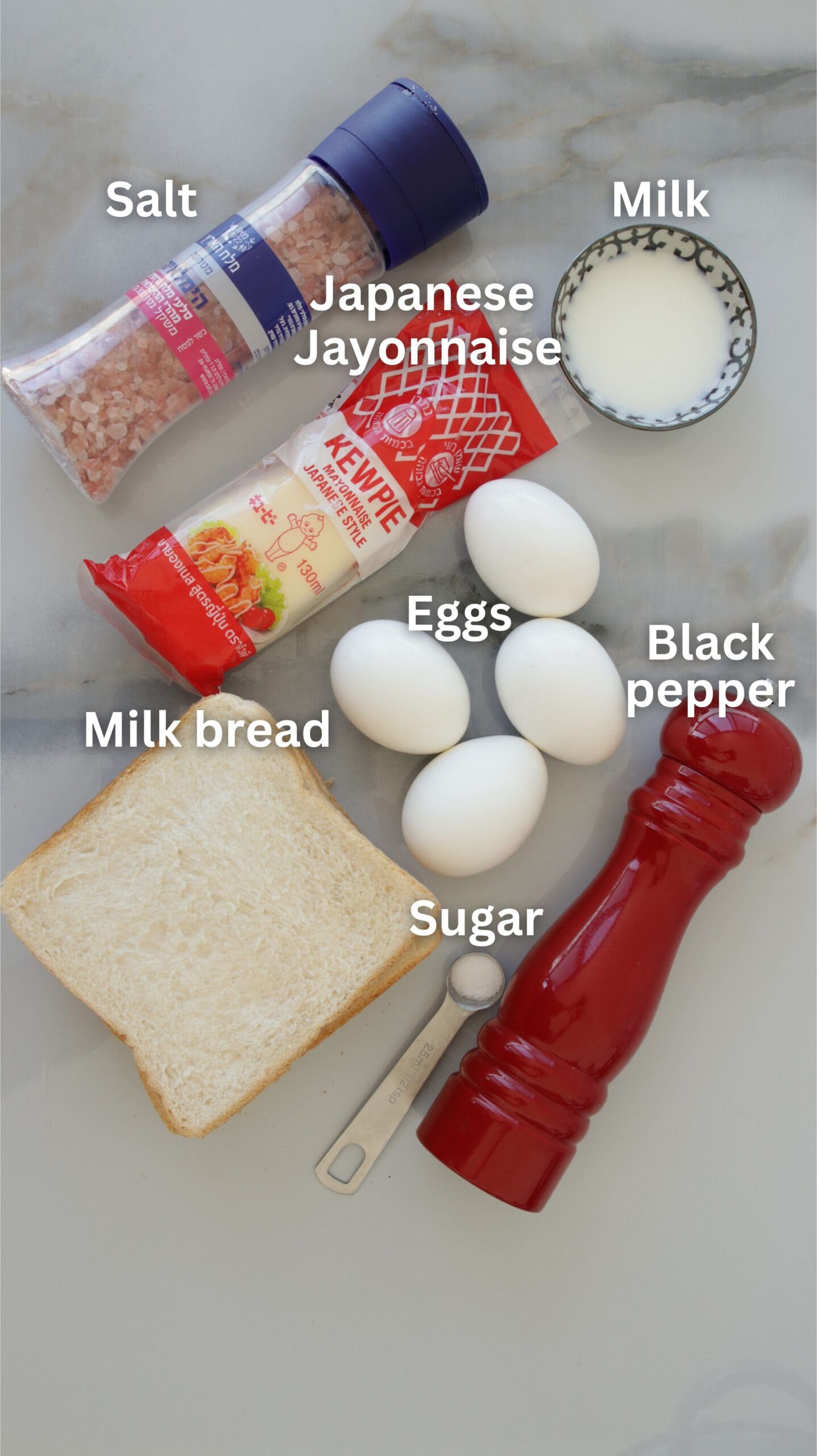
Here’s a closer look at what you’ll need to make these easy and delicious Japanese egg sandwiches, or tamago sando. These simple ingredients come together to create a perfectly creamy, fluffy, and flavorful sandwich.
- Eggs: The star of the show! You’ll be boiling and mashing these to make the rich and creamy egg salad. The key here is separating the yolks from the whites, so you can get that smooth, velvety texture for the filling.
- Japanese Mayonnaise: This is what gives the sandwich its signature flavor. Japanese mayo, like Kewpie, is a bit sweeter and tangier than regular mayo, and it adds a lot of richness to the egg salad. If you don’t have Kewpie, regular mayo works too, but the taste won’t be quite the same.
- Milk or Cream: Adding milk or cream makes the egg mixture extra smooth and creamy. It helps bind everything together and gives the filling a lighter, fluffier consistency.
- Salt and Black Pepper: These are essential to seasoning the eggs and bringing out their flavor. You can go easy at first, and adjust as needed.
- Pinch of Sugar: This may seem unusual, but just a small pinch of sugar adds a subtle sweetness that balances out the mayo and the richness of the eggs.
- Soft White Milk Bread: Traditional shokupan or Japanese milk bread is ideal for this sandwich. It’s soft, fluffy, and has a slight sweetness that complements the creamy filling perfectly. If you don’t have shokupan, any soft white bread will work, but the texture won’t be quite the same.
- Unsalted Butter: Spreading a thin layer of butter on the bread helps keep it from getting soggy and adds a little extra flavor.
🤌 How to Make Homemade Japanese Egg Sandwich
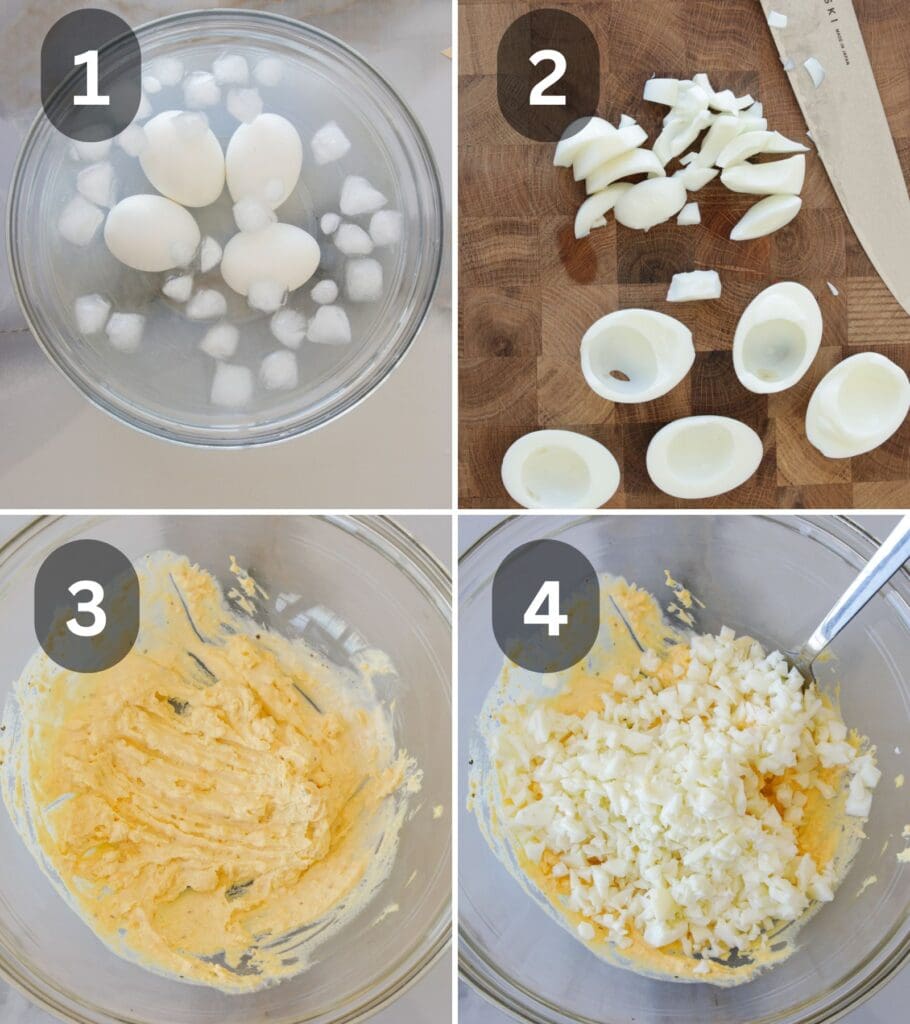
- Boil the Eggs
Place the eggs in a saucepan and cover with cold water. Bring the water to a boil, then turn off the heat and cover the pan. Let the eggs sit in hot water for about 10 minutes, then transfer them to an ice bath to cool completely. Peel and set aside. - Prepare the Egg Salad
Separate the egg yolks from the whites. Mash the yolks in a bowl with Japanese mayonnaise, a pinch of sugar, milk or cream, salt, and pepper until smooth. Chop the egg whites and fold them into the yolk mixture, combining well. - Assemble the Sandwich
Butter one side of each slice of soft white bread (ideally shokupan). Spread the egg salad evenly on two slices, then top with the remaining bread, buttered side down. - Serve and Enjoy
For an authentic touch, trim the crusts and cut the sandwiches into halves or quarters. Serve immediately and enjoy your homemade Japanese egg sandwich!
🪄 Tips and Tricks to Make The Best Japanese Egg Sandwich
To make your authentic Japanese egg sandwich even more delicious, here are a few tips and tricks:
- Use Japanese Mayonnaise
While you can use regular mayo, Japanese mayonnaise (like Kewpie) is key to getting that authentic flavor. It’s creamier, with a slight sweetness and tang that really complements the eggs. It’s worth trying if you can find it! - Cut for Presentation
For a neat and professional presentation, use a sharp knife to cut the sandwich. Whether you prefer halves or quarters, a clean cut gives it that signature tamago sando look. - Add a Touch of Mustard
- For a subtle flavor boost, you can add a tiny bit of Dijon mustard to the egg yolk mixture. This gives a slight tang that pairs well with the rich, creamy texture of the tamago sando.
- Wrap and Chill Before Serving: For an even more enjoyable sandwich, try wrapping your assembled tamago sando tightly in plastic wrap and placing it in the fridge for 15-20 minutes before serving. This helps the sandwich hold together better and allows the flavors to meld. The slight chill also gives the sandwich a refreshing, firm texture, making it easier to slice and serve neatly.
🗒 Variations for Japanese Egg Sandwich (Tamago Sando)
Here are some creative twists you can try to make your Japanese egg sandwich even more exciting:
- Spicy Tamago Sando
Add a little heat to your egg salad by mixing in a small amount of sriracha or a dash of wasabi. This adds a bold, spicy kick while still keeping the creamy texture intact. - Avocado Egg Sandwich
For a healthier twist, mash half an avocado into the egg salad mixture. The avocado adds creaminess and a rich flavor, making it a perfect match for the Japanese egg sandwich recipe. - Bacon and Egg Sando
Crisp up some bacon and crumble it into the egg salad. The smoky, salty bacon pairs beautifully with the creamy eggs, giving you a tamago sando recipe with a savory twist. - Cucumber and Egg Sandwich
Thinly sliced cucumbers add a refreshing crunch to the classic Japanese egg sandwich. Layer the cucumber slices on top of the egg salad before closing the sandwich for a light and fresh variation. - Cheese Tamago Sando
For an extra indulgent version, add a slice of mild cheese (like cheddar or Gouda) to the sandwich. The cheese will melt slightly, giving the sandwich a richer, more decadent flavor.
These variations keep the core of the Japanese egg sandwich while adding fun, tasty twists. Would you like help developing any other variations?
🗒 Substitutions
Here are some great substitutions to use in case you don’t have all the traditional ingredients on hand, while still keeping the essence of a Japanese egg sandwich:
- Japanese Mayonnaise Substitute
If you don’t have Kewpie mayonnaise, you can use regular mayonnaise and add a small splash of rice vinegar and a pinch of sugar. This will mimic the tangy, slightly sweet flavor of Japanese mayo. - Shokupan (Japanese Milk Bread) Substitute
If you can’t find shokupan, any soft, white sandwich bread will work. Look for a brand that’s fluffy and slightly sweet to get close to the texture of Japanese milk bread. - Milk/Cream Substitute
If you don’t have milk or cream, you can use unsweetened plain yogurt or Greek yogurt. This will add a bit of tang and keep the egg salad creamy. - Butter Substitute
For a dairy-free option, you can use margarine or a plant-based butter alternative. The butter helps prevent the bread from getting soggy, so it’s important to still include something to serve that purpose.
These substitutions will help you adapt the Japanese egg sandwich recipe to whatever ingredients you have on hand, while still maintaining its delicious flavor. Let me know if you’d like more specific substitution ideas!
👝 How to Store Leftovers
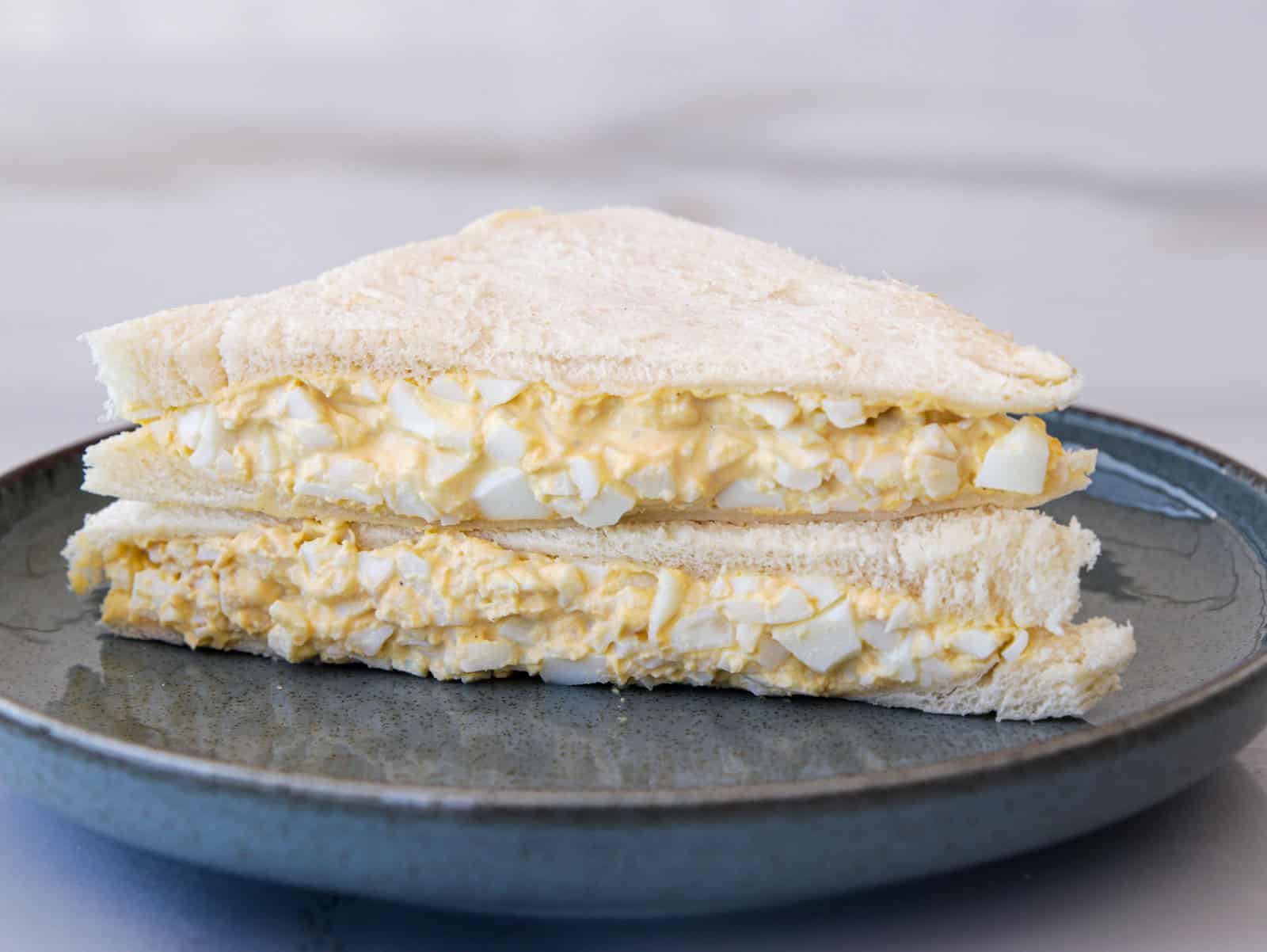
If you have leftover Japanese sandwiches (tamago sando), here’s how to store them to keep them fresh:
- Wrap Tightly
To maintain the softness of the bread and the freshness of the egg salad, wrap each sandwich tightly in plastic wrap. This will help prevent the bread from drying out and keep the egg salad from getting soggy. - Refrigerate
Place the wrapped sandwiches in an airtight container or ziplock bag and store them in the refrigerator. The sandwiches will stay fresh for up to 24 hours, but it’s best to eat them sooner rather than later to keep the bread soft. - Avoid Freezing
Freezing isn’t recommended for tamago sando, as the texture of the egg salad and bread will change, becoming watery and less appetizing once thawed.
Storing your Japanese egg sandwich properly ensures it stays delicious even after a few hours or overnight! Would you like more tips on serving leftovers?
More Sandwich Recipes
If you enjoyed this authentic Japanese sandwich, you might also like these sandwiches:
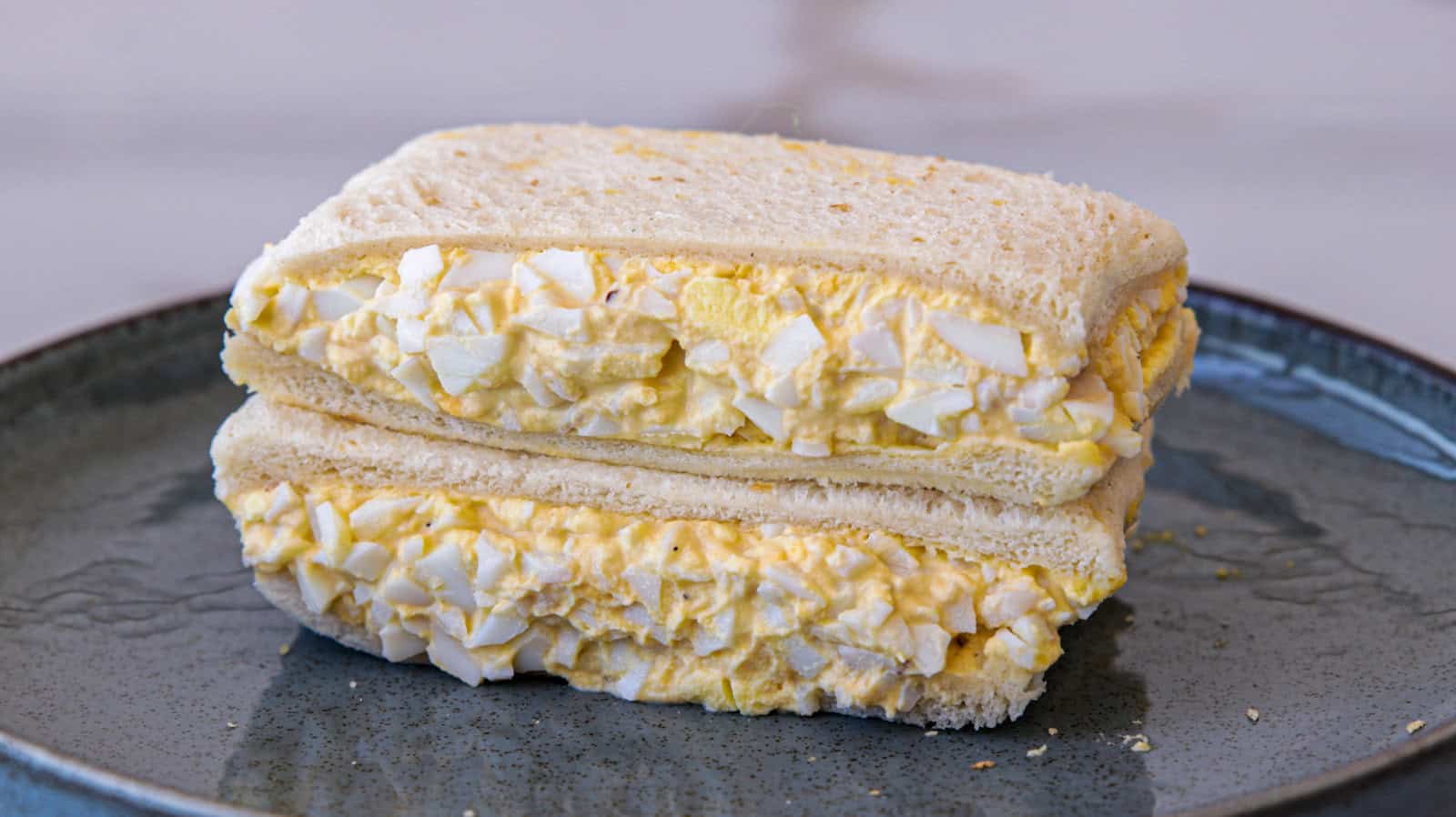
Japanese Egg Sandwich Recipe | Tamago Sando
Equipment
- Japanese knife *Use promo code: FoodieSpecial20 to get 20% off!
- Saucepan (affiliate link)
Ingredients
- 4 Eggs
- 2-3 tablespoons Japanese mayonnaise
- 2 tablespoons Milk/cream
- Salt to taste
- Black pepper to taste
- Pinch Sugar
- 4 slices Soft white bread Japanese milk bread or shokupan is ideal
- Unsalted butter
Instructions
Prepare the eggs:
- Place the eggs in a medium saucepan and cover with cold water.
- Bring the water to a boil over medium-high heat. Once boiling, cover the saucepan and turn off the heat. Let the eggs sit in the hot water for 10 minutes.
- After 10 minutes, transfer the eggs to an ice bath to cool completely.
- Peel the eggs and set aside.
Make the egg salad:
- Separate the egg yolks from the egg whites. Add the egg yolks to a bowl and the egg whites to a chopping board.
- In the bowl with the egg yolks, add the Japanese mayo, salt, black pepper, sugar, and cream or milk. Mash the yolks and mix it all together until you have the consistency of a thick sauce or paste.
- Chop the egg whites into small pieces and add then add them into the bowl with the egg yolks mixture. Combine all together.
- Taste and adjust seasoning if needed.
Assemble the Sandwich:
- Spread a thin layer of softened butter on one side of each bread slice (read recipe notes). This helps prevent the bread from getting soggy and adds a delicious flavor. If using
- Divide the egg salad evenly between the two slices of bread. Spread the egg salad to cover the entire slice evenly. Place the remaining slices of bread, buttered side down, on top of the egg salad to form a sandwich.
- For an authentic presentation, trim the crusts off the sandwiches. Cut each sandwich into halves or quarters, depending on your preference.
- Serve immediately and enjoy your Japanese egg salad sandwich!
Video
Notes
- Watch the Video: For a better understanding of the recipe, I always recommend watching the video recipe, which includes a step-by-step guide to help you succeed.
- FAQs: Make sure you read the FAQs for this recipe which are located below the recipe box for additional tips and troubleshooting! For extra tips and variations read the article.
- Use Japanese mayo for the authentic flavor! Regular mayo works, but Kewpie adds that special tangy sweetness.
- Pinch of sugar is optional, but it’s traditionally added to give the egg salad a subtle sweetness that balances the flavors.
- Butter is optional, but spreading a thin layer on the bread helps prevent sogginess and adds an extra layer of flavor.
Nutrition
🤔 Common Questions
The key differences are the smooth, creamy texture of the egg salad (thanks to the mashed yolks and Kewpie mayo), the slightly sweet flavor, and the use of shokupan, a soft and fluffy Japanese milk bread that’s typically served without crusts.
Yes, you can use regular mayo, but Kewpie mayonnaise has a unique sweetness and tanginess that gives the sandwich its authentic flavor. If using regular mayo, you can add a pinch of sugar and a bit of rice vinegar to mimic the taste.
Yes, while shokupan is the traditional bread for a Japanese egg sandwich, you can use any soft, fluffy white bread. The softer and lighter the bread, the better it complements the creamy egg salad.
Store your Japanese egg sandwich in the fridge for up to 24 hours by wrapping it tightly in plastic wrap. This prevents the bread from drying out and keeps the sandwich fresh, though it’s best enjoyed the day it’s made.
Trimming the crusts is optional but recommended for an authentic tamago sando. The soft, crustless bread makes the sandwich easier to eat and complements the smooth, creamy filling.
Yes, to make a vegan version, substitute the eggs with silken tofu, mash it for a creamy texture, and season with black salt (for an “eggy” flavor), turmeric, and vegan mayo. Use dairy-free butter and plant-based bread to complete the sandwich.



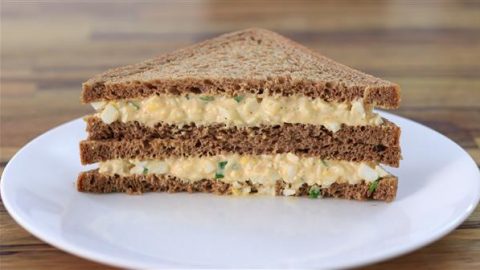

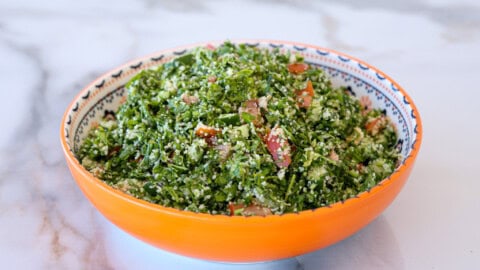



my fav sandwich